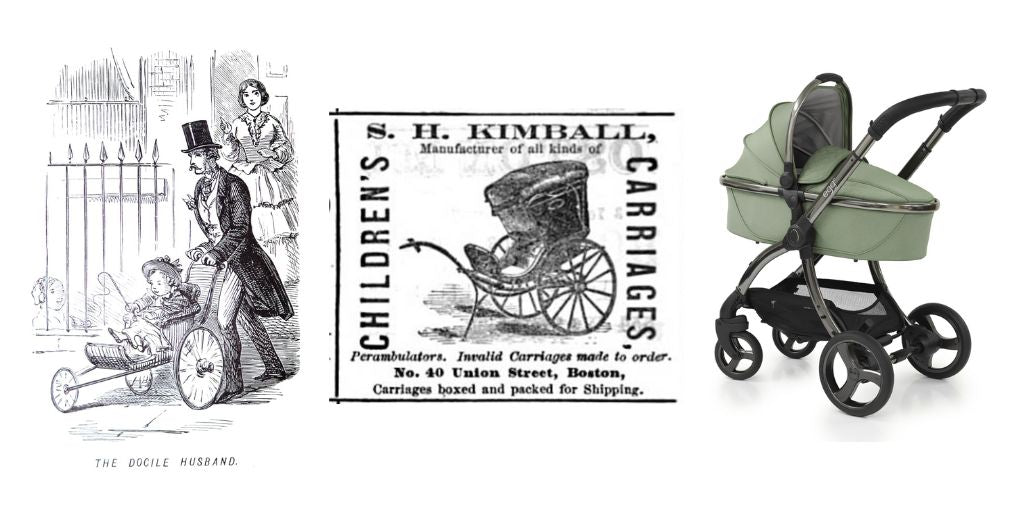The complete guide to carrycots for new parents
Today, we're focusing on a piece of baby equipment that often becomes a staple during the early months of parenting: the carrycot.
Our comprehensive guide aims to provide you with a thorough understanding of carrycots, backed by expert advice and research, so you can make informed decisions for your family.
In order to not have to say the same thing repeatedly, this guide is written on the basis that it is the parent's responsibility to ensure that any carrycot used conforms to required safety standards.
What is a carrycot?
A carrycot is essentially a compact, portable bassinet designed for transporting your baby. It provides a flat, sturdy surface for babies to lie on and is typically suitable from birth until around approximately 6 months old.
If your pushchair or stroller doesn’t feature a 100% lie-flat seating option, then a carrycot is a must as it allows a newborn to lie completely flat on their back which is the correct position for safe sleep.
This flat position is recommended by health experts, including The Lullaby Trust, for every sleep during the day and night, as it can help support with spinal development and growth and is the preferred sleeping position for easier breathing. This is especially important during the early months when newborns spend a significant amount of time sleeping.
As stated by The Sleep Foundation, ‘it is recommended that newborns have 14-17 hours of sleep within a 24-hour period, therefore it’s crucial that their sleeping environment is safe and comfortable.’
Who invented the carrycot?
We don't know who invented the carrycot but we do know how the pram itself was developed and the carrycot was a part of this journey.
The first "baby carriage" was invented in 1733 by William Kent for the Duke of Devonshire. It was a shell shaped basket on wheels that children could sit in and was highly decorated and supposed to be pulled by a goat or a small pony. This was something only for the rich as the middle class and working poor could never afford such an opulent baby toy.
Benjamin Potter Crandall sold baby carriages in the US in the 1830s which have been described as the "first baby carriages manufactured in the US". Then in 1848, an American inventor, Charles Burton, created the first recognizable stroller called the “perambulator" which had a three-wheel push design and is where we most likely get the word pram from.
In 1889, William H. Richardson walked into a Baltimore patent office with an idea that forever changed the look of prams and strollers. His idea used a special joint to allow a bassinet to be turned to face the operator (who in those days was more likely to be a member of the house staff than the parents) or face away and thus was created the first reversible baby carriage.
The term carrycot became more common in the UK after the introduction of lighter prams with detachable baby carriers in the 1970s. In a nutshell, a carrycot combines the traditional aspects of a bassinet or moses basket with the convenience of portability when attached to a pram.
What are the benefits of using a carrycot?
Choosing a carrycot offers several benefits, such as providing a comfortable and secure environment for your baby. Doctors and health professionals often emphasize the importance of providing infants with a flat sleeping surface, which aids in proper spinal development and safer sleep.
Carrycots are designed for flat sleeping which is safer as in the first three months as most babies at that age can’t lift their head and sitting upright can restrict baby's airway and make it hard for baby to breathe but they don't have the neck strength yet to lift their own head to help them breathe.
Are carrycots safe?
According to the American Academy of Pediatrics (AAP), a safe sleep environment is one that includes a firm sleep surface covered by a fitted sheet, which is what a standard carrycot provides.
Is it better for babies to sleep in a carrycot rather than an infant car seat?
Many parents wonder about whether it’s safe to let their baby sleep in an infant car seat and this is when carrycots are often highlighted as an option for their safety and comfort for extended sleeping as well as their portability.
The primary concern for not to use an infant car seat for a baby to sleep in is the risk of positional asphyxia, which can occur when a baby’s heavy head falls forward, causing difficulty breathing or even suffocation. This is because infants in this age group do not have the strength to lift and move their heads to ensure an open airway.
A study analysing infant sleep-related deaths found that 3% of these deaths occurred in sitting devices (like car seats), with most happening when the car seat was not used for its intended purpose and was instead brought into the home for continued sleep.
One of the key points here is that carrycots give baby a completely flat sleeping environment, which is crucial for a newborn’s spinal development and may reduce the risk of SIDS (Sudden Infant Death Syndrome).
The Lullaby Trust sums it up when it states: “Car seats are designed to keep babies safe while travelling, not as a main sleeping place. Car seats should only be used for transport and not as an alternative for cots or highchairs. It’s ok for your baby to fall asleep in a car seat when travelling, but they should be taken out as soon as you get to your destination, and placed onto a firm, flat surface to sleep.”
So can a carrycot be used for daytime naps?
Carrycots can be used for daytime naps, which is in keeping with the suggestion that infants should sleep in the same room as their parents for the first six months, as advised by many healthcare experts. It's easy to keep baby nearby in a carrycot as it's so highly portable and provides a flat, safe sleeping environment for baby.
Can a carrycot be used as moses basket?
While similar to moses baskets, carrycots often offer more stability and can also be attached to certain strollers which means you can get out of the house at baby's naptime.
The Lullaby Trust suggests that whatever option you choose should have a firm, flat, waterproof base.
The good news if you have a SnoozeShade Original is that it fits neatly over a carrycot or a moses basket. This can be useful in the early days when baby might sleep in the moses basket and you may not want that sleep disturbed by well-meaning visitors.
Can a carrycot be used for baby to sleep in overnight?
Some carrycots are suitable for overnight sleeping, but it is essential to check the manufacturer's information to ensure that they are appropriate. Some pram maunfacturers like Bugaboo, iCandy and Cybex have had their latest carrycots approved for unsupervised or overnight sleep. This is unusual and so do check each brand's safety information.
The National Childbirth Trust (NCT) advises that if a carrycot is used for overnight sleeping, it should be stable, well-ventilated, and without soft bedding. It's best if young babies are on a firm, flat, waterproof mattress for at least the first 6 months.
There is no mandatory testing for carrycots in the UK as there is for car seats, but looking out for a carrycot that complies with the new European standard EN 1466:2023 will provide peace of mind for parents as it's more rigorous than the previous standard EN 1466:2014+AC:2015 which will be withdrawn by June 2024.
This covers vital considerations such as the internal depth of the carrycot, entanglement hazards and sufficient ventilation and airflow, and ensures that the sleeping environment within the carrycot for babies under 6 months old is as safe as that in a Moses basket, crib or cot.
Cybex and Bugaboo join a number of other manufacturers who have already put their carrycots through the testing, including Oyster, egg and iCandy, with UPPAbaby, Silver Cross and Peg Perego also offering carrycot stands. Having a carrycot stand means parents can confidently extend the lifespan of using a carrycot.
What age does carrycot go up to and when is it time to stop using a carrycot?
Typically, carrycots are used from birth until approximately 6 months old. Most carrycots are designed to be used until the point when baby can roll over, sit up unaided, or has reached a weight of about 9kg (20 lbs), whichever comes first.
It also depends on how tall or long your baby is, some youngsters grow much quicker than others, and so they stop being able to fit in a carrycot sooner than the manufacturer's guide. As ever, be guided by your child's personal development.
The transition from a carrycot to a seated stroller should occur when your baby shows signs of outgrowing it, either by developmental milestones or size. It's important to watch your baby and make the change before these limits are reached to ensure their safety.
Typically, carrycots are used from birth until approximately 6 months old. However, it's essential to follow guidelines specific to the carrycot model you own and your child's growth and mobility. Remember that this is an approximate age – some little ones start sitting up or attempting to sit up much earlier.
In conclusion, a carrycot can be an excellent investment for the early months of a baby's life, offering convenience, comfort, and safety.






